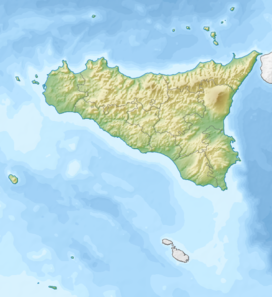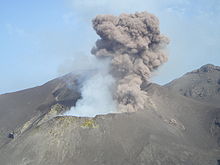geo.wikisort.org - Mountains
Stromboli (/ˈstrɒmbəli/ STROM-bə-lee, Italian: [ˈstromboli]; Sicilian: Struògnuli [ˈʂː(ɽ)wɔɲɲʊlɪ]) is an island in the Tyrrhenian Sea, off the north coast of Sicily, containing Mount Stromboli, one of the four active volcanoes in Italy. It is one of the eight Aeolian Islands, a volcanic arc north of Sicily. Strabo writes that people believed that this is where Aeolus lived.[3]
| Stromboli | |
|---|---|
 Aerial view of Stromboli from the northeast; to the right, the Sciara del Fuoco can be seen | |
| Highest point | |
| Elevation | 924 m (3,031 ft)[1] |
| Prominence | 924 m (3,031 ft)[1] |
| Coordinates | 38°47′38″N 15°12′40″E |
| Naming | |
| Native name | |
| Geography | |
 Stromboli Aeolian Islands, north of Sicily (Italy) | |
| Geology | |
| Age of rock | 150,000 |
| Mountain type | Stratovolcano |
| Last eruption | 1934 to present [2] |
| Climbing | |
| Easiest route | Hike |

The island, with an area of 12.6 square kilometres (4.9 sq mi),[4] represents the upper third of the volcano.[5] Its population was about 500 as of 2016[update].[6] The volcano has erupted many times and is constantly active with minor eruptions, often visible from many points on the island and from the surrounding sea, giving rise to the island's nickname "Lighthouse of the Mediterranean".[7]
Etymology
Its name is derived from the Ancient Greek name Strongýlē, (Στρογγύλη) which was derived from στρογγύλος (strongýlos, "round"), after the volcano's round, conical appearance when seen from a distance.[8] [9]
Height and shape
Stromboli is an island in the Tyrrhenian Sea, off the north coast of Sicily, containing Mount Stromboli, one of the three active volcanoes in Italy. It is one of the seven Aeolian Islands, a volcanic arc north of Sicily; these islands are also known as the Lipari Islands.
Stromboli stands 926 m (3,038 ft) above sea level,[2] and over 2,700 m (8,860 ft) on average above the sea floor.[5]
The island's area is 12.6 square kilometres (4.9 sq mi).[4]
There are three active craters at the peak. A significant geological feature of the volcano is the Sciara del Fuoco ("stream of fire"), a big horseshoe-shaped depression created in the last 13,000 years by several collapses on the northwestern side of the cone. Approximately 2 kilometres (1+1⁄4 miles) northeast lies Strombolicchio, the volcanic plug remnant of the original volcano.
Volcano

Mount Stromboli has been in almost continuous eruption for the past 2,000–5,000 years;[7] its last serious one occurred in 1921.[4] A pattern of eruption is maintained in which explosions occur at the summit craters, with mild to moderate eruptions of incandescent volcanic bombs, a type of tephra, at intervals ranging from minutes to hours. This pattern of Strombolian eruption, as it is known, is also observed at other volcanoes worldwide.
Eruptions from the summit craters typically result in a few short, mild, but energetic bursts, ranging up to a few hundred meters in height, containing ash, incandescent lava fragments and stone blocks. Stromboli's activity is almost exclusively explosive, but lava flows do occur at times when volcanic activity is high: an effusive eruption occurred in 2002, the first in 17 years, and again in 2003, 2007, and 2013–14. Volcanic gas emissions from this volcano are measured by a multi-component gas analyzer system, which detects pre-eruptive degassing of rising magma, improving prediction of volcanic activity.[10]
On 3 July 2019, two major explosive events occurred at around 16:46 local time, alongside 20 additional minor explosive events identified by Italy's National Institute of Geophysics and Volcanology. A hiker near the volcano's summit died after being struck by flying debris when the eruption began.[11][12][13] Additionally, 6 people suffered minor injuries due to the eruption.[14]
On 28 August 2019, at 10:16 local time, an explosive eruption sent a pyroclastic flow down the volcano’s northern flank and into the sea, where it continued for several hundred meters before collapsing. The resulting ash column reached a height of 2,000 m (6,600 ft).[15]
Settlements

The two villages San Bartolo and San Vincenzo lie in the northeast while the smaller village Ginostra lies in the southwest.[16] Administratively, they are one of the frazione (unit of a commune and municipality) of Lipari, Messina.
In the early 1900s a few thousand people inhabited the island,[17] but after several waves of emigration the population has numbered a few hundred since the mid-1950s.[18] The population on the island was about 500 as of 2016[update].[6]
In addition to Italian, a derivative of the Sicilian dialect that is called Aeolian is generally spoken on this and the other Aeolian islands.[19]
In popular culture
- In Journey to the Center of the Earth (1864) by Jules Verne, the conclusion of the novel is set on Stromboli.
- Author J. R. R. Tolkien identified his fictional volcano Mount Doom in Mordor with the volcano of Stromboli, according to scholar Clyde S. Kilby.[20]
- Stromboli (1950), also known as: Stromboli, Land of God, is an Italian-American film set on Stromboli, directed by Roberto Rossellini and starring Ingrid Bergman.
- Rising Appalachia's 2015 song "Stromboli" was written on and titled after the island. The studio version appears on Wider Circles (2015) and a live version appears on Alive.[21]
See also
References
- "Stromboli, Italy". Peakbagger.com. Retrieved 20 July 2013.
- "Stromboli". Global Volcanism Program. Smithsonian Institution. Retrieved 1 January 2009.
- Strabo (1903) [1877]. Meineke, A. (ed.). "The Geography of Strabo". Translated by Hamilton, H.C.; Falconer, W. Leipzig: Teubner – via Perseus Digital Library.
- Tikkanen, Amy. "Stromboli Island, Italy". Encyclopedia Britannica. Retrieved 5 May 2021.
- Tibaldi, A.; Corazzato, C.; Marani, M.; Gamberi, F. (2009). "Subaerial-submarine evidence of structures feeding magma to Stromboli Volcano, Italy, and relations with edifice flank failure and creep". Tectonophysics. 469 (1): 112–136. Bibcode:2009Tectp.469..112T. doi:10.1016/j.tecto.2009.01.031. Retrieved 5 May 2021.
- "Isola di Stromboli" [Stromboli Island] (in Italian). Comune di Lipari. Retrieved 25 February 2016.
- Scheffel, Richard L.; Wernet, Susan J., eds. (1980). Natural Wonders of the World. United States: Reader's Digest Association, Inc. pp. 360–361. ISBN 0-89577-087-3.
- Strabo (1892). The Geography of Strabo. Bohn's classical library,v. 74-76. Vol. 1. Translated by Hamilton, H.C.; Falconer, W. London, England: George Bell & Sons. p. 419.
footnote 4 of Book VI, Chapter II, §11
- Bunbury, Edward Herbert (1856). "Aeoliae Insulae". In Smith, William (ed.). Dictionary of Greek and Roman Geography. Vol. 1. London, England: Walton and Maberly. pp. 51–52.
- Aiuppa, Alessandro; Federico, Cinzia; Giudice, Geatano; Papale, Paolo (11 October 2008). "The 2007 eruption of Stromboli volcano: Insights from real-time measurement of the volcanic gas plume CO2/SO2 ratio". Elsevier. Retrieved 27 September 2016.
- "Stromboli: One dead as volcano erupts on Italian island". BBC News. 3 July 2019. Retrieved 3 July 2019.
- Hunter, Marnie; Simon, Darran (3 July 2019). "Volcanic eruption rocks Italian island of Stromboli, kills 1 hiker". CNN. Retrieved 3 July 2019.
- Andrews, Robin. "Deadly Explosions Just Rocked Italy's Stromboli Volcano – Here's What Happened". Forbes. Retrieved 3 July 2019.
- Isolino, Giovanni (4 July 2019). "Stromboli clears up ash after deadly volcano eruption". Phys Org. Retrieved 30 April 2021.
- INGVvulcani. "Comunicato di attivita' vulcanica del 2019-08-28 11:41:57 (UTC) – Stromboli" [Volcanic activity announcement of 2019-08-28 11:41:57 at Stromboli]. Facebook (in Italian). Archived from the original on 26 February 2022. Retrieved 29 August 2019.
- Alean, Jürg; Roberto Carniel; Marco Fulle (21 May 2005). "Stromboli 1952–1953 – The village and the land". Stromboli online. Retrieved 31 August 2010.
- Loschiavo, LindaAnn. "Return of the Native to Stromboli". Retrieved 31 August 2010.
high point of 2,100 citizens in 1891
- Alean, Jürg; Roberto Carniel; Marco Fulle (21 May 2005). "Stromboli 1952–1953 – Stromboli in 1952 and 53". Stromboli online. Retrieved 31 August 2010.
- Zampaglione, Francesca (10 August 2015). "Lipari news e curiosita' dalle isole eolie" [The Aeolian dialect and its linguistic influences]. Lipari News (in Italian). Retrieved 14 June 2021.
- Kilby, Clyde S; Plotz, Dick (1968). "Many Meetings with Tolkien: An Edited Transcript of Remarks at the December 1966 TSA Meeting". Niekas. Niekas Publications, New Hampshire, United States (19): 39–40. Referred to at tolkienguide.com and by another publication of the Niekas editor.
- Wooldridge, Talia (2017). "Alive with Rising Appalachia: A Conversation with Leah Smith". Spill. Retrieved 30 December 2021.
External links
 Stromboli travel guide from Wikivoyage
Stromboli travel guide from Wikivoyage- Information about Stromboli and on its seismic monitoring network (italian)
- BBC documentary Island of Fire
- Scuola In Mezzo Al Mare School in the Middle of the Sea documentary (2019)
На других языках
[de] Stromboli
Stromboli ist eine italienische Insel mit dem gleichnamigen, aktiven Vulkan vom Typ eines Strato- oder Schichtvulkans. Die Insel liegt im Mittelmeer nördlich von Sizilien.- [en] Stromboli
[es] Estrómboli
Estrómboli (en italiano: Stromboli) es una pequeña isla italiana en el mar Tirreno, cuya principal característica es la de ser la cima emergida del volcán activo homónimo. La isla corresponde a las islas Eolias, un archipiélago volcánico al norte de Sicilia. Su nombre es una corrupción del antiguo nombre griego Στρογγυλή (Stroŋgulḗ) que se le dio por su forma redonda y abombada. El año 2000 fue inscrita junto al resto del archipiélago en la lista del Patrimonio de la Humanidad de la Unesco.[1][fr] Stromboli
Stromboli, en italien Isola di Stromboli, est une île volcanique d'Italie faisant partie des îles Éoliennes située au nord de la Sicile, dans le bassin tyrrhénien de la mer Méditerranée.[it] Isola di Stromboli
Stromboli (Struògnuli in siciliano[1]) è un'isola italiana appartenente all'arcipelago delle isole Eolie, in Sicilia. Posta nel bacino Tirreno del mar Mediterraneo occidentale, l'isola è la più settentrionale delle Eolie e si estende su una superficie di 12,2 km². Sull'isola è presente il vulcano omonimo. L'Isola di Stromboli ospita due centri abitati: Stromboli (a sua volta suddiviso nelle località di Scari, San Vincenzo, Ficogrande e Piscità) e Ginostra, dall'altra parte dell'isola. Il principale approdo è situato a Scari.[ru] Стромболи
Стро́мболи (итал. Stromboli, сиц. Struògnuli) — маленький вулканический остров с действующим вулканом. Расположен в Тирренском море к северу от Сицилии, принадлежит группе Липарских островов. Остров принадлежит Италии. Название происходит от латинской формы strongulē др.-греч. слова στρογγύλη («круглый»), благодаря округлой выпуклой форме острова с диаметром около 4 км. Площадь острова — 12,5 кв. км.Другой контент может иметь иную лицензию. Перед использованием материалов сайта WikiSort.org внимательно изучите правила лицензирования конкретных элементов наполнения сайта.
WikiSort.org - проект по пересортировке и дополнению контента Википедии

